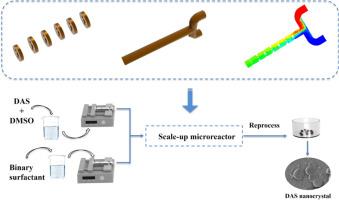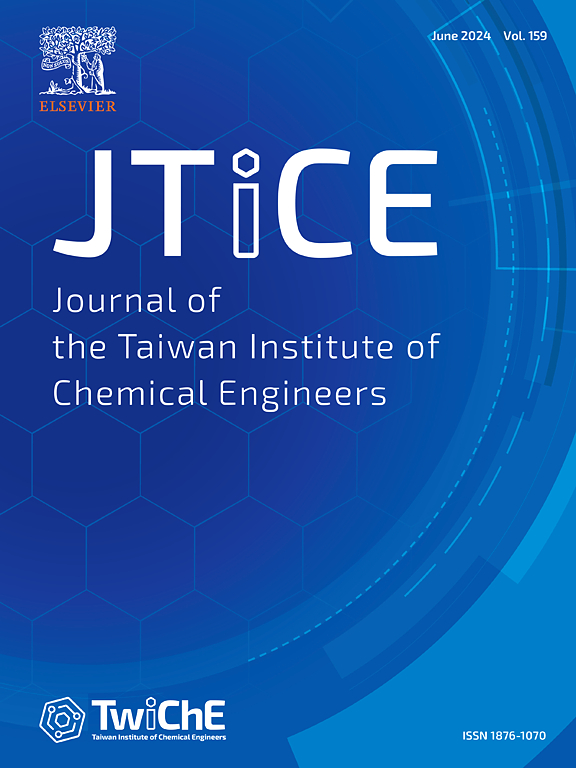放大微反应器耦合二元表面活性剂,高通量制备片状达沙替尼纳米晶体
IF 5.5
3区 工程技术
Q1 ENGINEERING, CHEMICAL
Journal of the Taiwan Institute of Chemical Engineers
Pub Date : 2024-11-28
DOI:10.1016/j.jtice.2024.105823
引用次数: 0
摘要
背景传统的纳米晶体制备方法往往存在粒度和形态控制不佳、产量低和不稳定等局限性。方法在本研究中,我们开发了一种新型微反应器技术,用于高效制备达沙替尼纳米晶体。采用的微反应器配有圆孔挡板,以提高混合效率。通过系统地改变溶剂与等溶剂的比例、流速和达沙替尼的初始浓度,对溶剂-等溶剂过程进行了优化。通过优化实验条件,成功制备出了性能优异的达沙替尼纳米晶体。纳米晶体的平均粒径为85 nm,ZETA电位为47.5 mV,多分散指数为0.566,显示出优异的分散性和稳定性。与传统方法相比,二元表面活性剂体系使纳米晶体的收缩率显著提高了 6.5-12 倍。通过精确控制微反应器内的混合动力学,可以生产出具有定制特性的高质量纳米晶体。此外,该方法的简便性、高效性和可调性也表明它有潜力向高通量纳米粒子制备方向扩展,从而拓宽其在各个领域的应用前景。本文章由计算机程序翻译,如有差异,请以英文原文为准。

Scale-up microreactor coupling binary surfactants for high-throughput preparation of flaky dasatinib nanocrystals
Background
Traditional methods for nanocrystal preparation often suffer from limitations such as poor control over particle size and morphology, low yield and instability.
Methods
In this study, we developed a novel microreactor technique for the efficient preparation of dasatinib nanocrystals. The microreactor employed was equipped with a circular hole baffle to enhance mixing efficiency. The solvent-antisolvent process was optimized by systematically varying the solvent-to-antisolvent ratio, flow rate, and initial concentration of dasatinib. A binary surfactant system (SDBS/BS-12) was introduced in the anti-solvent phase to further improve the nanocrystal properties.
Significant Findings
The optimized experimental conditions led to the successful preparation of dasatinib nanocrystals with exceptional properties. The nanocrystals exhibited an average particle size of 85 nm, a zeta potential of 47.5 mV, and a polydispersity index of 0.566, indicating superior dispersion and stability. Compared to conventional methods, the binary surfactant system resulted in a remarkable 6.5–12 times enhancement in nanocrystal shrinkage. The precise control over mixing dynamics within the microreactor enabled the production of high-quality nanocrystals with tailored properties. Furthermore, the simplicity, efficiency, and tunability of the proposed method suggests its potential for scale-up towards high-throughput nanoparticle preparation, broadening its application prospects in various fields.
求助全文
通过发布文献求助,成功后即可免费获取论文全文。
去求助
来源期刊
CiteScore
9.10
自引率
14.00%
发文量
362
审稿时长
35 days
期刊介绍:
Journal of the Taiwan Institute of Chemical Engineers (formerly known as Journal of the Chinese Institute of Chemical Engineers) publishes original works, from fundamental principles to practical applications, in the broad field of chemical engineering with special focus on three aspects: Chemical and Biomolecular Science and Technology, Energy and Environmental Science and Technology, and Materials Science and Technology. Authors should choose for their manuscript an appropriate aspect section and a few related classifications when submitting to the journal online.

 求助内容:
求助内容: 应助结果提醒方式:
应助结果提醒方式:


